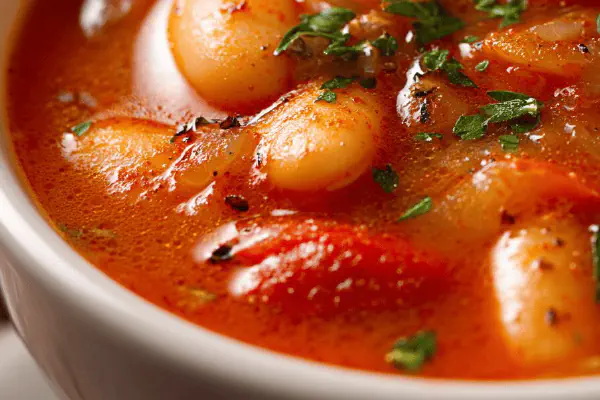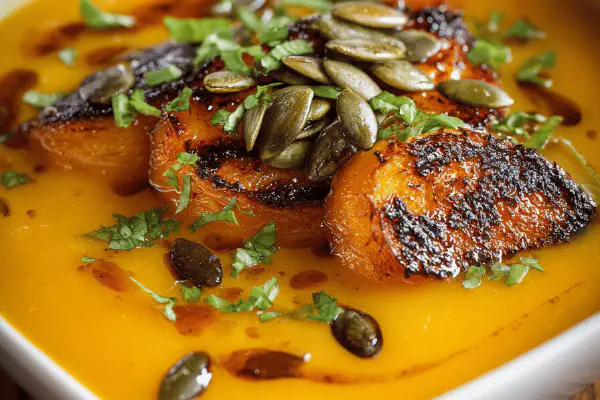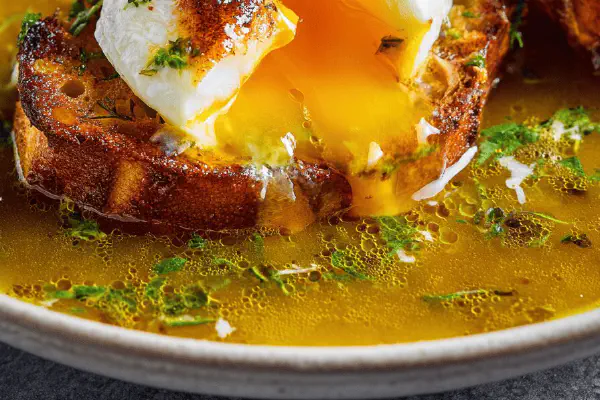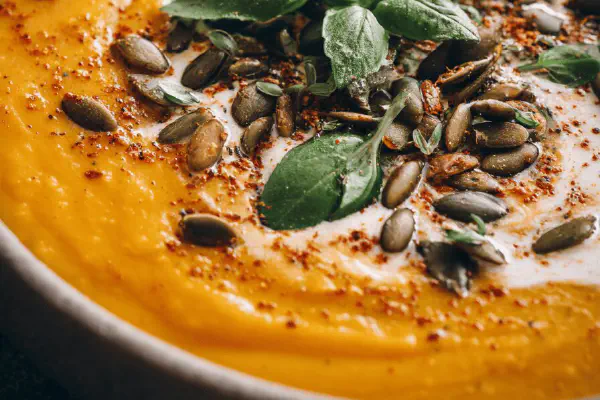Tomato White Bean Soup

E
By Emma
Certified Culinary Professional
•
Recipe tested & approved
A chunky, rustic, tomato-based soup with creamy white beans and a hint of spice. Sautéed shallots and diced celery join garlic to build depth. Cannellini beans swapped in for a smoother texture. Smoked paprika adds unexpected warmth, breaking the usual tomato-bean routine. The broth starts with vegetable stock but chicken stock works fine if you want extra body. Pureeing is optional but recommended for velvety consistency. Cook until carrots yield easily under a fork and aroma thickens the kitchen. No gluten, nuts, dairy, or eggs. Weeknight-friendly, forgiving soup with simple pantry staples.
Prep:
25 min
Cook:
20 min
Total:
45 min
Servings:
4 servings
#soup
#French cuisine
#vegan option
#gluten-free
#comfort food
Tomato and white beans — classic combo, yet every time I make it, something changes. I’ve played with onions, celery, different garlic ratios, olive oil amounts. Usually, I overcook the garlic or under-season, ending with flat, tired soup. This one, I tossed shallots instead of onions; the softer, swifter onion flavor pushes the aromatics just a notch brighter. Toss celery in for texture and subtle flavor contrast — keeps it lively. Sometimes, tomatoes can feel one-dimensional — so I added a whisper of smoked paprika, because smoky depth wakes up bland. White beans swap caster beans for something creamier, silkier. I’ve learned to eyeball softness rather than rely on clocks—know your pot! Soups aren’t about rigid times; they’re about aromas thickening, bubbles dancing, textures changing. Puree or leave chunky, both work; pureed is smoother, more comforting on grim nights. I keep some broth handy to loosen, never prayer-to-thickens-only. Salt last because beans hide salt—season carefully. No gluten, dairy, nuts, or eggs; clean, safe for many diets. It’s humble, wholesome, a bit smoky, yet refined. A simple bowl but born from trials and errors in the kitchen haze.
Ingredients
- 1 shallot, finely chopped
- 1 celery stalk, diced
- 3 cloves garlic, minced
- 25 ml (1 ½ tablespoon) olive oil
- 1 can 796 ml (28 oz) crushed Italian tomatoes
- 1 can 540 ml (19 oz) cannellini beans, rinsed and drained
- 500 ml (2 cups) vegetable or chicken broth
- 1 teaspoon smoked paprika
- Salt and cracked black pepper to taste
About the ingredients
Shallots instead of onions bring a more delicate, slightly sweeter background that blends without overpowering. Celery offers subtle aromatic crunch, balancing the softness of beans and tomatoes—skip if you’re short on time or stock but it adds crucial texture here. Garlic presence is essential but carefully monitored to avoid bitterness—mince finely for gentle release; smash then chop isn’t recommended here. Smoked paprika is a personal twist; it adds a velvety warmth and smokiness that you won’t see coming but works well. Cannellini beans chosen over standard white beans for their creamy texture and less starchy mouthfeel—you could use navy beans but expect more graininess. Tomatoes should be good quality canned; crushed, not whole, helps with texture. Broth can be vegetable for vegan, chicken if you want extra richness—avoid bouillon cubes with excessive salt or MSG; homemade broth always preferable. Olive oil quality impacts aroma—extra virgin recommended.
Method
- Heat oil in a wide pot over medium-high heat; wait for it to shimmer but not smoke.
- Add shallots and celery, stirring frequently so they soften but don’t brown—about 5 minutes. You want their sweetness, not bitterness.
- Throw in garlic and smoked paprika; stir quickly until aromatic, just 1-2 minutes. Beware of letting garlic burn—it turns bitter fast.
- Pour in crushed tomatoes followed by beans and broth. Give a good stir to combine; simmer uncovered so sauce thickens slightly.
- Let bubbles pop steadily on surface; after roughly 18-20 minutes, poke carrot pieces with fork if using fresh (optional) to check softness.
- Remove pot from heat; either leave chunky or use immersion blender carefully to puree soup until velvety smooth. Thin with extra broth if too thick.
- Season with salt and pepper—taste early and often. Beans can add natural sweetness, so balancing is key.
- Serve warm, maybe with crusty bread or a drizzle of olive oil, but no creams or cheese—forgone to keep it pure.
Cooking tips
Fat shimmering signals oil temperature, means ideal time to add aromatics; don’t rush this or you lose flavor depth. Saw this done wrong—throw cold veggies and oil, ending with bland base. Softer shallots and celery need gentle heat, stirring so they don’t brown; burnt bits poison the pot here. Garlic added last to prevent burning; it cooks fast, just aromatic release, no color. Smoked paprika added with garlic, stirring to release essential oils but never letting spice stick to pan edges—burns. Simmer uncovered to encourage evaporation and thicken liquid; bubbling constantly but gently. Use tactile test on vegetables, fork slips in carrot easily—key signal. Pureeing after removing from heat prevents splatters, reduces risk. Blend intermittently rather than blitz in one go, control texture. Adjust seasoning at the end because beans carry natural salt. Too thick? Thin with broth. Too thin? Simmer a bit more. A splash of fresh lemon juice or balsamic vinegar at the end could brighten but optional. Serve hot; aromas rise through the room, comfort inside a bowl.
Chef's notes
- 💡 Heat oil until it shimmers but no smoke or flavor loss. Lowish heat for shallots and celery to soften without browning, toss every minute. Burnt bits turn bitter fast, wreck base. Garlic goes in last, quick stir, just aromatic. Monitor color—no brown garlic.
- 💡 Use quality canned crushed tomatoes good texture vital; whole tomatoes mess up soup mouthfeel. Cannellini beans rinse well, prevent starchy grain. Navy beans stand in but less creamy. Broth: veggie or chicken for richer boost but skip salty bouillon cubes, homemade is best workaround.
- 💡 Simmer uncovered; bubbles steady, not wild boil. Watch aroma shift, kitchen thickens, carrots poke with fork if used. Timing varies with heat source, pots. Puree after heat off to avoid splatter and control texture. Blend in bursts, use immersion blender for safety.
- 💡 Season last. Beans bring hidden salt and sweetness, salt early means overdone. Pepper cracked, freshly ground then taste again. If too thick after puree, add broth incrementally. Too thin? Back on stove few minutes, evaporation is your friend. Acid splash optional; lemon or vinegar brighten unexpectedly.
- 💡 Celery not mandatory but adds crunch and aroma. Skip if rushing but you lose texture contrast. Shallots preferred to onions, much sweeter, subtle flavors—cut onions if none, expect sharper punch. Smoked paprika added with garlic, quick stir, careful not to burn spice oils—burnt paprika is harsh.
Common questions
Can I substitute other beans?
Yes. Navy beans work but texture grainier. Chickpeas possible but flavor changes. Rinse well always. Creaminess less with alternatives.
What if garlic burns?
Toss it. Bitter wrecks entire pan. Start over may be best. Add garlic late, keep low heat. If burnt, add acid after to balance bitterness but no cure-all.
Can I make it vegan?
Use vegetable broth only. Skip chicken broth. Oil stays same. Watch salt levels with broth choice. Home broth less salty than store, adjust at end always.
How to store leftovers?
Cool quickly. Fridge up to 4 days. Reheat gently on stove, add broth to loosen if thickened. Freeze in airtight container good up to 3 months. Defrost slowly, stir before serving.



